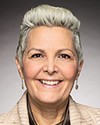Thanks, Madam Chair, and thanks again to the witnesses for being here.
I want to continue where we left off, because I had so many more questions. We were talking about the operating budget.
As I said, we have a cost of living crisis, so taxpayers watching are very mindful of ensuring that money is efficiently used. We have $68 million to grants and contributions for advancing gender equality—just under $70 million. We were talking about the $537,000 for operating costs.
I'm curious. You said you have hundreds of applications. That's why you need to have this high number. What is the formula that decides how much each employee is paid to do a...? What is the formula that decides salary?
What I want to point out here.... My colleague Ms. Vien brought this up. She asked you a question. She wanted to know how the number of employees has changed since 2015, when Prime Minister Trudeau took office. You guys have gone from 70 employees to 400 employees. That is a significant number. When we talk about bureaucracy and the cost of living crisis, that's a significant amount of money in salaries.
Can you explain the formula that decides how you come up with an operating budget that is almost 10% of the budget for advancing gender equality?





